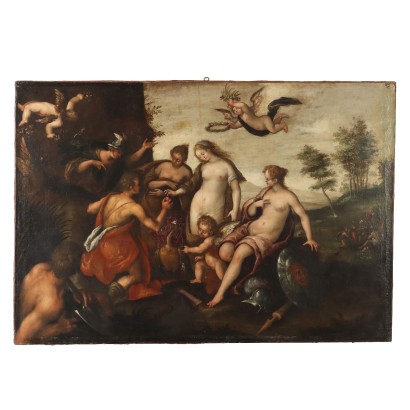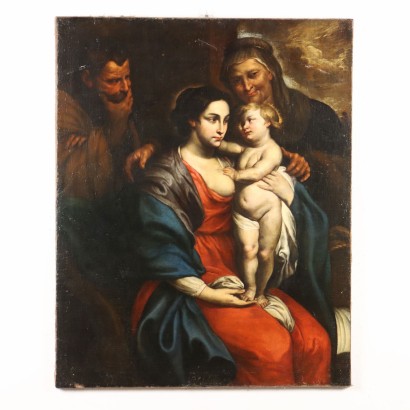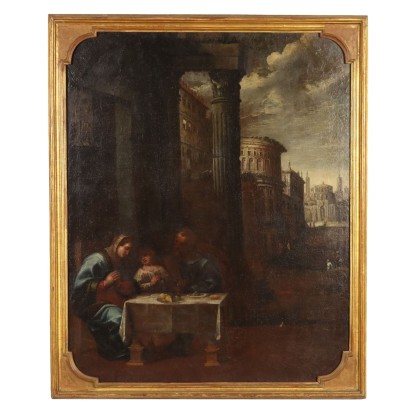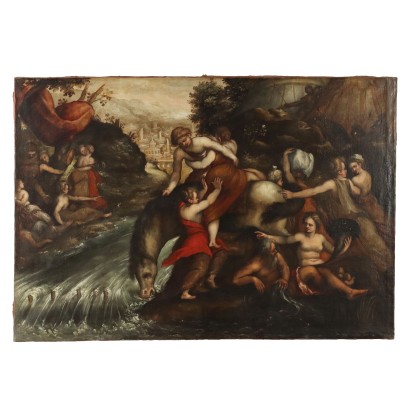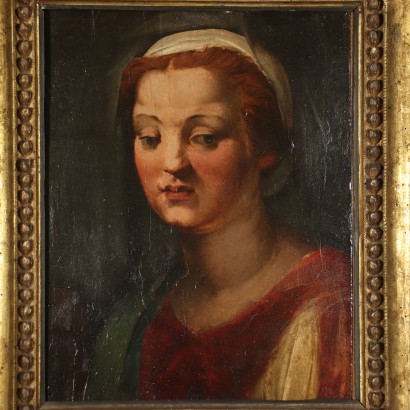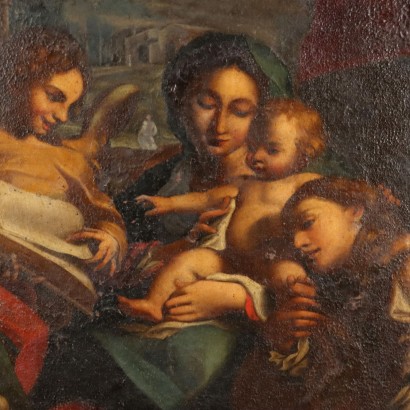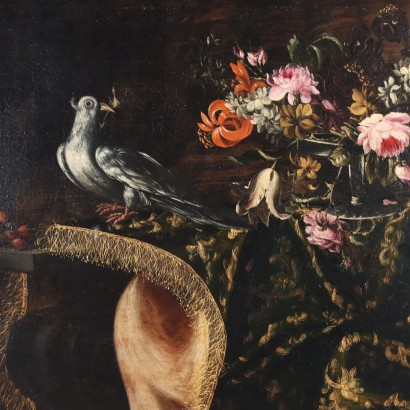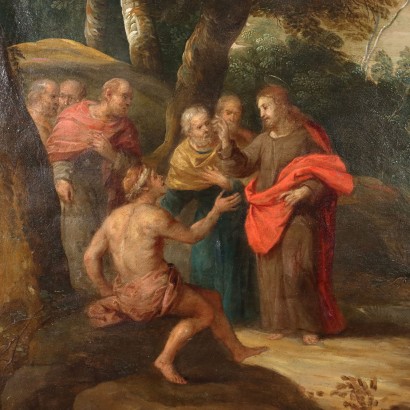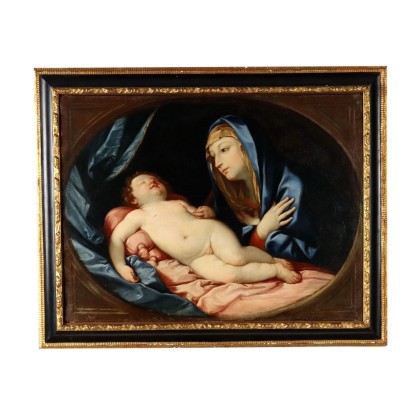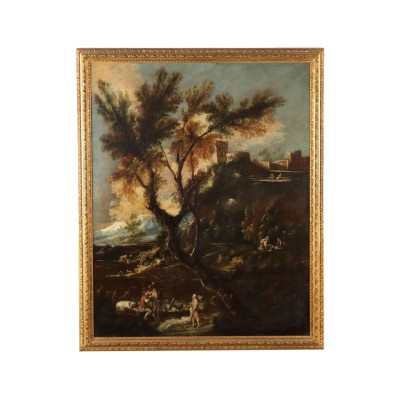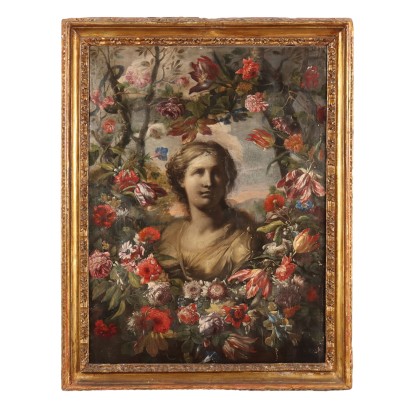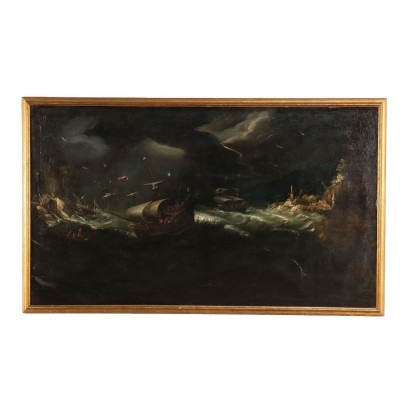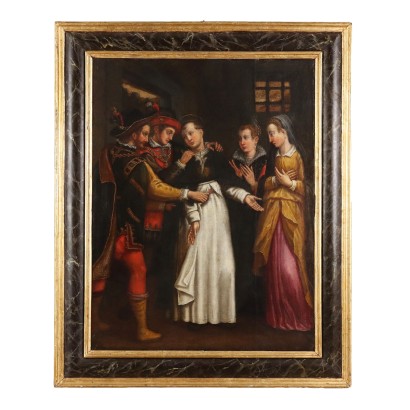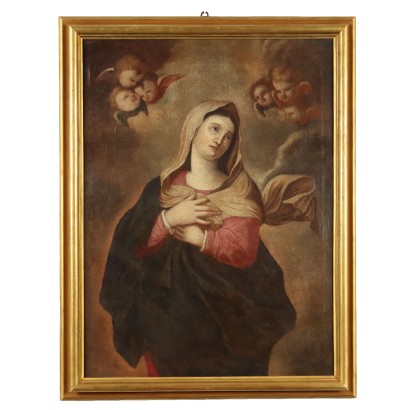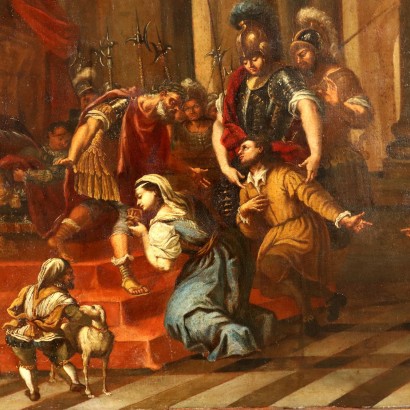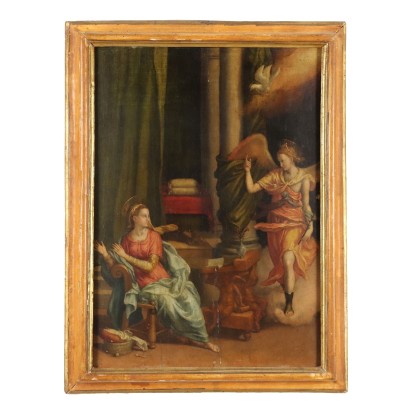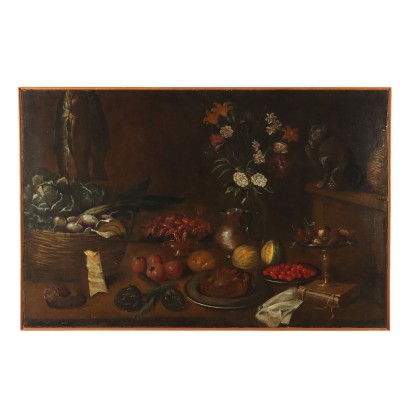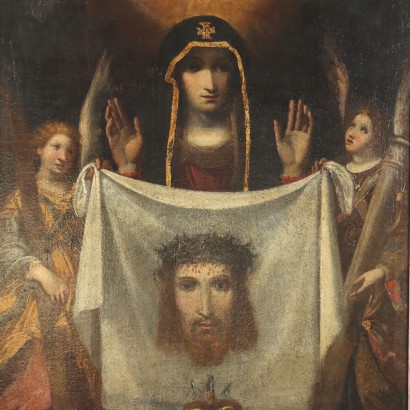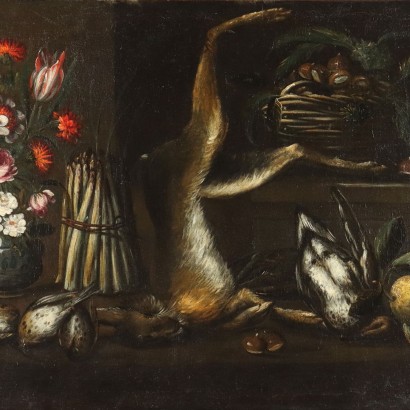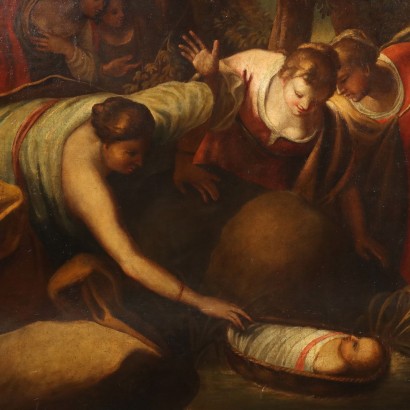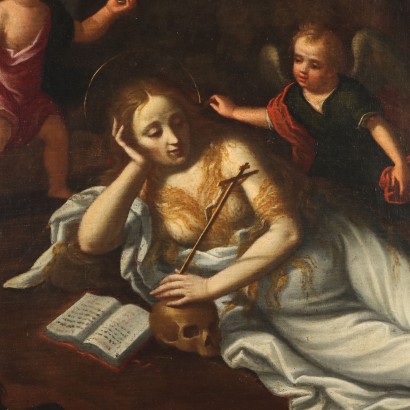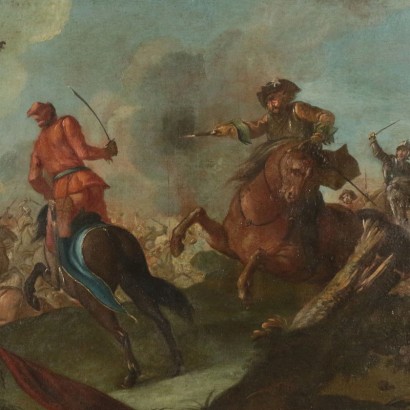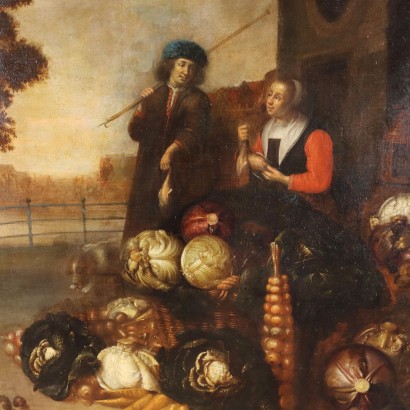Antique Painting with Mythological Subject Attr. to Domenico Lupini - Attr. to Domenico Lupini
Features
Attr. to Domenico Lupini
Artist: Domenico Lupini Attributed to
Artwork title: Il giudizio di Paride
Age: 17th Century / 1601 - 1700 , 16th Century / 1501 - 1600
Subject: Allegorical/Mythological Subject
Artistic technique: Painting
Technical specification: Oil on Canvas
Description : Il giudizio di Paride
Oil painting on canvas. The model derives from an engraving by Marcantonio Raimondi based on a drawing by Raphael, specially created for the graphic work, and derived from a painting located in the Stanza della Segnatura (1513-1515) in the Vatican Museums. This model was subsequently taken up and varied both in painted works and in other engravings, in particular in that of Raphael Sadeler of 1589, currently in the Cabinet of Drawings and Prints of the Accademia Carrara in Bergamo: the painting proposed here in fact shows the same changes made compared to the Raphaelesque original. At the center of the mythological scene immersed in a natural landscape, are the three goddesses who competed for the title of the most beautiful: Juno with the peacock, her symbolic animal, Venus accompanied by Cupid, and Minerva next to whom are the helmet, the spear and the shield. Paris, from behind, is giving the golden apple that declares the winner to the goddess of love, under the gaze of judge Mercury. Two putti flutter around the protagonists, while in the foreground, always from behind, there is a male figure. A country boarding school is taking place on the lawn behind. The work, as attested by a small scroll, is attributed to Domenico Lupini, an artist about whom not much is known but whose sphere of activity can be hypothesized between Bergamo and Venice. The only two signed works are a "Converted Magdalene" and an "Annunciation", but other works have been attributed to him by the scholar Federica Nurchis and placed in the monastery of Santa Chiara in Bergamo. The painting presents a warm and refined chromaticism which, together with the elegance of the characters and the compositional method, suggest a Venetian stay for Lucini, which seems to recall the atmospheres of Tintoretto, Veronese and Palma il Giovane. The painting shows signs of restoration and relining.
Product Condition:
Product in fair condition showing some signs of wear. We try to present the real state as fully as possible with photos. If some details are not clear from the photos, what is stated in the description applies.
Artwork dimensions (cm):
Height: 137
Width: 199
Depth: 3
Additional Information
Artist: Domenico Lupini
Age:
17th Century / 1601 - 1700
17th Century / 1601 - 170016th Century / 1501 - 1600
16th Century / 1501 - 1600Subject: Allegorical/Mythological Subject
Artistic technique: Painting
La pittura è l'arte che consiste nell'applicare dei pigmenti a un supporto come la carta, la tela, la seta, la ceramica, il legno, il vetro o un muro. Essendo i pigmenti essenzialmente solidi, è necessario utilizzare un legante, che li porti a uno stadio liquido, più fluido o più denso, e un collante, che permetta l'adesione duratura al supporto. Chi dipinge è detto pittore o pittrice. Il risultato è un'immagine che, a seconda delle intenzioni dell'autore, esprime la sua percezione del mondo o una libera associazione di forme o un qualsiasi altro significato, a seconda della sua creatività, del suo gusto estetico e di quello della società di cui fa parte.Technical specification: Oil on Canvas
The oil painting is a painting technique using powder pigments mixed with bases in inert and oils.Other customers have searched:
Pittura antica, artisti italiani, pittura olio su tela, arte 800, pittura antica, arte novecento, oggetti d'arte, ritratto di signora, dipinto animali, quadro paesaggio montano, dipinto olio su tela, dipinto antico, dipinti natura morta, quadro antico, quadro del '600, pittori italiani quadri olio su tela paesaggi, paesaggio marino dipinto, paesaggio invernale dipinto, paesaggio autunnale dipinto, dipinto di paesaggio, arte antica, quadro religioso..
Se sei un appassionato d'arte, non perderti i nostri approfondimenti sul Blog Arte Di Mano in Mano e su FineArt by Di Mano in Mano - Arte:
Leggi di più
Ecco alcuni tra i principali articoli:
Vedute
Falsi nell'arte antica
Un messaggio di fiducia per ripartire
La potenza espressiva dell'arte figurativa etiope
Breve Storia del Collezionismo
Giorgio Upiglio, maestro dei libri d'artista
Matthias Withoos detto "Calzetta bianca"
San Rocco pensaci tu - Classic Monday
Dai un'occhiata alle nostre rubriche di divulgazione sull'arte:
Epoche
Lavorazioni e tecniche
Mostre ed Eventi
Protagonisti
Se sei appassionato di pittura antica, con tutta probabilità gusterai le schede di questi stupendi quadri:
"Dio parla a Noè dopo il diluvio", Jacopo da Ponte, detto il Bassano, seconda metà XVI secolo
Crocifissione, maestro della misericordia dell'accademia, terzo quarto del XIV secolo
Erminia incontra i pastori, Camillo Gavassetti, Seconda metà anni Venti del XVII Secolo
Eroine dell'antichità, Francesco Conti, XVIII secolo
Hieronymus III Francken, La Negazione di Pietro, XVII secolo
Jefte e la figlia, Girolamo Forabosco e aiuti, XVII secolo
L'Accademia di Platone, piccolo arazzo, fine XVII - inizio XVIII secolo
Maddalena e San Giovanni Battista
Natura Morta, Bartolomeo Arbotori, XVIII secolo
Sacra Famiglia con San Giovannino, Bartolomeo Ramenghi, scuola di, prima metà XVI secolo
Testa Femminile, Andrea del Sarto, ambito di, post 1522
Uva, fichi, melagrana e pesche su un capitello - Maximilian Pfeiler, primo quarto XVIII secolo
Sapevi che l'arte può essere anche un ottimo investimento (e non solo per grandi portafogli)?
L'Arte tra Collezionismo e Investimento
FineArt: Arte come investimento
Leggi di più
Ecco alcuni tra i principali articoli:Vedute
Falsi nell'arte antica
Un messaggio di fiducia per ripartire
La potenza espressiva dell'arte figurativa etiope
Breve Storia del Collezionismo
Giorgio Upiglio, maestro dei libri d'artista
Matthias Withoos detto "Calzetta bianca"
San Rocco pensaci tu - Classic Monday
Dai un'occhiata alle nostre rubriche di divulgazione sull'arte:
Epoche
Lavorazioni e tecniche
Mostre ed Eventi
Protagonisti
Se sei appassionato di pittura antica, con tutta probabilità gusterai le schede di questi stupendi quadri:
"Dio parla a Noè dopo il diluvio", Jacopo da Ponte, detto il Bassano, seconda metà XVI secolo
Crocifissione, maestro della misericordia dell'accademia, terzo quarto del XIV secolo
Erminia incontra i pastori, Camillo Gavassetti, Seconda metà anni Venti del XVII Secolo
Eroine dell'antichità, Francesco Conti, XVIII secolo
Hieronymus III Francken, La Negazione di Pietro, XVII secolo
Jefte e la figlia, Girolamo Forabosco e aiuti, XVII secolo
L'Accademia di Platone, piccolo arazzo, fine XVII - inizio XVIII secolo
Maddalena e San Giovanni Battista
Natura Morta, Bartolomeo Arbotori, XVIII secolo
Sacra Famiglia con San Giovannino, Bartolomeo Ramenghi, scuola di, prima metà XVI secolo
Testa Femminile, Andrea del Sarto, ambito di, post 1522
Uva, fichi, melagrana e pesche su un capitello - Maximilian Pfeiler, primo quarto XVIII secolo
Sapevi che l'arte può essere anche un ottimo investimento (e non solo per grandi portafogli)?
L'Arte tra Collezionismo e Investimento
FineArt: Arte come investimento
Product availability
The product can be seen at Cambiago
Immediate availability
Ready for delivery within 2 working days from ordering the product.



